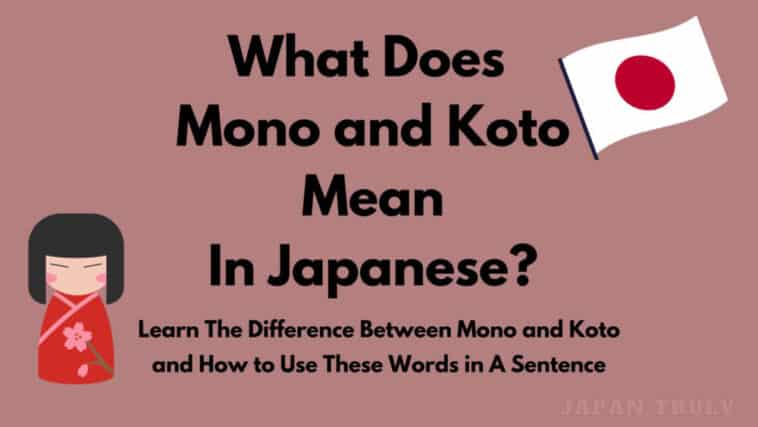Wondering what is the meaning of mono and koto in Japanese? And what is the difference between mono and koto!
Every language is unique. They have their own pronunciation and spelling. When it comes to Japanese, there are certain words that either sound similar but have different meanings or sound different but have similar meanings.
One of those different kinds of words are – Mono and Koto. In Japanese, Mono is written as もの, whereas Koto is written as こと. When you translate the word, it means “thing”.
The only trick here is that even though the translation is the same, there is a slight difference in their meanings. In this article we will understand in depth what these two Japanese words mean.
Meaning Of Mono And Koto

Meaning of Mono (物) in Japanese
If we go by dictionary meaning, mono is an expletive noun that describes a concrete thing. It is something that you can physically feel and touch. It is tangible, for example – door, table, etc. The concept of mono can be used to convey the idea of anything at all, including an object, article, material, substance, possessions, property, or belongings.
In the Japanese language, there are two other words that can be read as Mono. One of the meanings is “person” (者), whereas the other meaning is a “thing” (物). Given, it is an expletive noun, we write it as hiragana もの.
Moreover, the word is also used to emphasize emotions or judgments and can be used to talk about a common occurrence in the past.
Using mono in a sentence
To understand the word better, let us have a look at some of the examples.
もし電気がないと、私たちの暮らしがどのようなものになるか想像できますか。
Can you imagine what our lives would be like without electricity?
その黒いものは猫かなあ.
I wonder if this black thing is a cat?
今まで使っていたものを今朝部屋でボール遊びをしていて、わってしまったのです。
I broke the one I’ve been using till now this morning while playing with a ball in the room.
インコを飼うために必要なものを揃えましょう。
Let’s get what we need to keep a parrot.
おいしいものが食べたい.
I want to eat something good.
- Related: Meaning of Ara Ara in Japanese
What does Koto mean?
Now that you are aware of what mono means, let us understand what koto means. It is also an expletive noun that expresses an abstract concept, such as an object, a thought, a state of consciousness, a situation, or an action. It is something that cannot be seen or touched because it is intangible. It provides you with an understanding of the subject matter, the incident, or the circumstances.
Koto in Hiranga is written as こと.

Using Koto in a sentence
大事な事を教えます.
I will tell you something important.
僕達は僕達の国の事を話した (ぼくたちはぼくたちのくにのことをはなした)
We talked about things about our country.
どう いうこと?
What is the meaning of this?
Koto in the Phrase ‘I Love You’
You must have understood the basic difference between Mono and Koto. Now, we will explore the most romantic and heartfelt phrase one can say to you – I love you. In the Japanese language, we say I love you as あなたのことが好きだ.
In many dramas, anime, and movies, you might have heard the characters say – anata no koto ga dai suki desu. Well, it means that they love you.
If you take the word “koto” out of the phrase, it still has the same meaning as “I love you” or “I like you,” which is something you might not know. However, why does it even exist?
Well, the Japanese love to add an extra layer of indirection to expressions of affection. This is due to the fact that Koto refers to figurative things. The addition of the word places a greater emphasis on the word “you.”
Taking the meaning a step further, the addition of koto denotes that you are showing the other person a more profound form of love by expressing it in some way. It indicates that you adore every facet of their personality.
It sounds different than when you say the words without the koto. Simply adding “I love you” followed by “Koto” transforms the meaning of the phrase and gives it more gravitas.
If you take the word “koto” in its literal sense, which is to say that it expresses an abstract idea such as an item, a thought, a state of consciousness, a situation, or an action, you will gain more insight into its meaning.
When you say, “あなたのことが好きだ” you are indicating that there are aspects of the other person that you cannot even see. For instance, their thoughtfulness, their intelligence, and a lot of other qualities. It simply indicates that you love the person an excessive amount and are willing to accept all of their characteristics.
- Related: Meaning of Daijoubu in Japanese
Difference Between Koto And Mono
The basic difference, as we have mentioned above, is the usage as well as the meaning of it. While both these words mean “thing”, the difference is the kind of “thing” we are referring to.
We’ve already mentioned the expletive noun. You must be curious as to what exactly it is at this point. Allow us to explain that there are two distinct types of nouns used in the Japanese language. One is substantive and the other one is expletive.
Nouns that can stand on their own in terms of meaning are referred to as substantive nouns. On the other hand, nouns that contain expletives are meaningless when taken by themselves.
For example – 時計/とけい/Tokei/Clock and 洋服/ようふく/Yofuku/Cloth are substantive nouns.
Whereas Koto and Mono are expletive nouns. This means that they are always used in conjunction with other words, which lends the expletive nouns additional connotations as well as grammatical functions. When placed into a sentence, Koto can be used to describe either an action or a circumstance. On the other hand, when referring to an individual thing or person, one would use the word mono.
For example – 人間というもの / にんげんというもの = Ningen to iu mono/human beings
When you look at these phrases, mono もの cannot be replaced with Koto こと. You must be wondering why?
Well, in this phrase もの refers to Ningen/Human which is a substantive noun. This means you can touch and feel that thing. Hence, Koto cannot replace the word.
目に見えること / めにみえること = Me ni mieru koto/What you can see
You can surely interchange Mono and Koto in this phrase. Let us tell you how. In the phrase, we have highlighted Koto (こと), now when we interchange it, we will get: 目に見えるもの
目に見えること means situation that is abstract. Whereas, when we interchange it, the meaning changes to something that is right in front of you.
Another example –
食べる事
Taberu koto
The act of eating, Food
食べる物
Taberu mono
Eat something
When you look at the above phrases, although the first part is the same, the second part is interchangeable. The meaning changes as we switch between Mono and Koto in the phrases.
Moreover, the words also have differences in phonological roots. Subjectivity is linked to the consonants “m” and “n,” both of which are nasal sounds; however, the velar “k” does not share this association.
Conclusion
Simply put, Mono refers to the tangible, Koto describes the intangible. Sometimes you can use one in place of the other, but that’s not always the case.
Also Read





